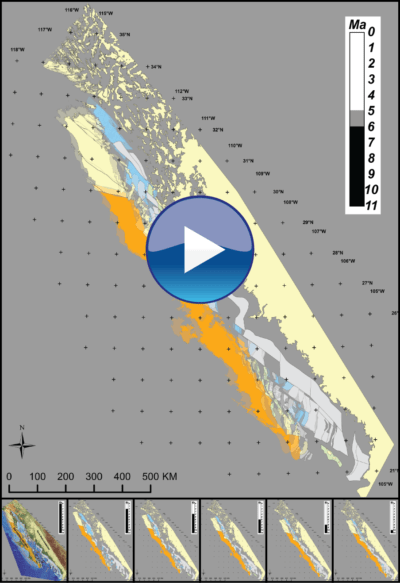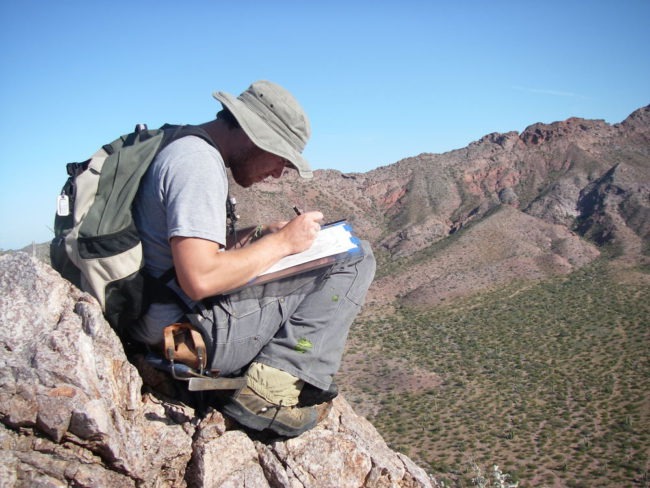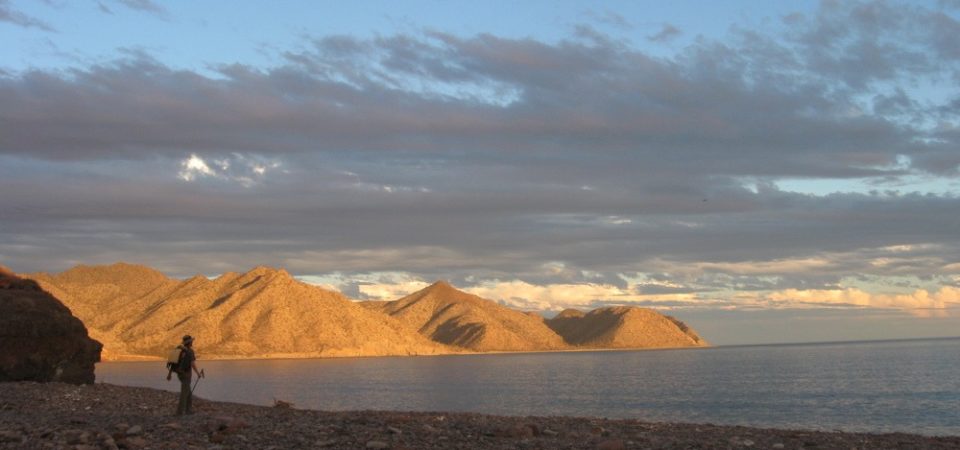Over the past weeks, the MAHB has had the pleasure of sharing the incredible collaborative work being created by the teams of 6&6. Forged by the Next Generation Sonoran Desert Researchers network (N-Gen, www.nextgensd.com), 6&6 is a collaboration between artists and scientists to explore the patterns and processes of the Sonoran Desert and Gulf of California. The MAHB has shared the partnerships of:
Ben Wilder and Ben Johnson, working to present the multi-layered story of the pozos, or fresh-water springs, in northwestern Mexico’s Grand Desierto and consider how our relationship to water has changed.
Chip Hedgcock and Mark A. Dimmitt, presenting the diaphanous plants of the Sonoran Desert and their unique sparseness through lumen printing.
Heather Green and Taylor Edwards, featuring the chuckwalla of La Cholla and how isolation has become its reality.
Eric Magrane and Maria Johnson, bringing attention to the by-catch of the shrimp trawling fishery in Mexico’s Gulf of California through illustration, poetry, video, and installation.
Kathleen Velo and Michael Bogan, finding ways to combine Kathleen’s underwater photogram work with Michael’s aquatic ecology research on desert freshwater communities.
This week we are highlighting the final team, Scott Bennett and Tom Baumgartner, who are creating the canvas upon which these other projects are positioned. Bennett is a field geologist working with the USGS and Baumgartner is an artist with extensive experience in data visualization and illustration. Together they are creating artistic renderings of how the physical landscape of the Gulf of California evolved through time — over the past 11 million years. In a project aiming to explore the patterns and processes of the Sonoran Desert and Gulf of California, Bennett and Baumgartner’s work provides a sense of how those patterns came to be –the geologic and plate tectonic forces behind the isolated mountains of La Cholla, the critical existence of the pozos, the rich marine resources of the Gulf, and even the desert itself. Baumgartner explains, “We’re going to step back in time and show not only the movement of different land masses but also the topography.”

The past topography of an area, or paleo-topography, has tremendous implications for the current landscapes and communities –both human and otherwise—that inhabit it. In the context of the Sonoran Desert and Gulf of California, these implications often come in the form of where water resources were located. Bennett says, “It’s important to understand what the physical landscape used to look like and how it evolved into what we walk around on today. Understanding how Earth’s surface evolved helps us understand why water resources are where they are. Topography plays a big role with the distribution of water and where people settled. The evolution of topography can inform us on a lot of different scales of humanity, where freshwater and other natural resources exist, and the evolution of the continent.” Bennett continues, “The way I think about the geology or the topography of any area is that it’s the canvas on which everything else exciting happens upon —through which they’re intimately and intricately connected.”

The intricacies of the Sonoran Desert canvas will be determined by Bennett’s research as interpreted by Baumgartner’s creativity and experience with visualizing data. Bennett describes his research: “As a field geologist we make observations about rocks types, their ages, and how they’ve moved over time. We use that information to glean information about the past geologic characteristics, and provide information about what the paleo-landscape used to look like. We create technical models that reconstruct the paleo-landscape and how it evolved.”
Baumgartner describes his charge as pulling from Bennett’s research and other sources, “to build…what the world was like 11 million years ago.” Baumgartner writes, “Geologic data can show where and when landforms were in the past but can only guess at the topological aspects during that time. Using hints from present topographic maps and the work of paleogeography scientists like Ron Blakey we’ll try to approximate what the terrain looked like millions of years ago.” Some of the hints come in surprising forms, which Baumgartner is learning to appreciate. Baumgartner recalls being “blown away” when Bennett told him “every rock on the planet has a magnetic signature in it that tells you what direction Earth’s magnetic field was pointing when the rock formed,” and continues, “As Scott points things out to me about terrain and what they look at over time it starts to create this concept of understanding.”

The process of fitting together evidence aligns well with Baumgartner’s preferred approach, which he calls world building. “In my work I try to convey a sense of the ancient and the future, to maintain a timeless aesthetic in it. In world building you pull from many different sources.” However, Baumgartner usually finds himself working at a smaller scale. “Usually I’m drawing a plant or a little animal. This, this is a big thing. Large scale in both time and space. I’m impressed with Scott that that’s where his head is every day, with things thousands of miles long and millions of years old.” Baumgartner also expressed admiration for Bennett’s depth of geologic knowledge, which he admits is starting to rub off. “I have more of an interest in geology now. Wouldn’t it be great to walk around the mountains, to point at a rock and say, ‘I know what that is!’? To be familiar with something that’s so common. For it to not be a mystery!”
Bennett acknowledges geology is a fascinating field partially because of its constant presence and influence on our lives. Yet explains, “As a research scientist I’m more focused on the data, on publishing papers and illustrating the concepts of the science.” An approach that does not always make geologic research accessible to the public. Bennett continues, “Working with Tom has been great because he comes at illustration from a different perspective…. I’m learning a lot from Tom about how to illustrate scientific knowledge.” For Baumgartner, “The interesting thing is that it’s not just an art project either. On this work there’s a sense of responsibility to Scott’s research too, to convey it, to point out parts of it that I find important, to communicate that.”

Original plans to create an interactive map as a touchscreen-display are in the process of being revamped. They plan to dig in a little deeper over the summer, once Baumgartner is able to revisit some of the design aspects. With Bennett in the Bay Area of California and Baumgartner in Tucson, they have long-distance to contend with, but explain that their working styles and the project they have taken on (which is currently primarily in digital format) have helped it be a smooth process, even as they change directions. Bennett explains, “I can’t say, ‘Hey Tom let’s go get a beer and talk about our project.’ However, when they do connect Bennett says, “It’s pretty rare if we’re not on the phone for about an hour-and-a-half at a time. It’s been a fun experience sharing and learning from each other.” Baumgartner agrees, and is looking forward to seeing how the project comes together. “I’m excited about the project. I think it’s going to look awesome. I can see it in my mind and I’m excited for once we get to that point. We’ve got a long way to go, but I think it’s going to be great.”
Once complete, both see their piece as serving as the canvas or stage for the larger 6&6 project. Their depiction of the evolution of the Sonora Desert landscape will pull together the disparate stories of the isolated chuckwallas of La Cholla, the disturbances of the Santa Cruz watershed, the threatened pozos, the odd forms of desert plants, and the complexities of shrimp trawling. They will all be intimately connected through the earth-shaping processes that have created the unique landscapes and seascapes of the Sonoran Desert and Gulf of California.
This project is part of the 6&6 collaboration introduced at the end of April. You can find out more about 6&6 here. The MAHB will be featuring additional scientist-artist partnerships from the collaboration in the coming weeks.
The above post is through the MAHB’s Arts Community space –an open space for MAHB members to share, discuss, and connect with artwork processes and products pushing for change. Please visit the MAHB Arts Community to share and reflect on how art can promote critical changes in behavior and systems and contact Erika with any questions or suggestions you have regarding the space.
MAHB Blog: https://mahb.stanford.edu/creative-expressions/creating-canvas/
The views and opinions expressed through the MAHB Website are those of the contributing authors and do not necessarily reflect an official position of the MAHB. The MAHB aims to share a range of perspectives and welcomes the discussions that they prompt.
